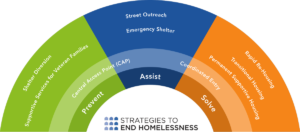 On June 20th, HUD released the FY18 Notice of Funding Availability (NOFA) for the Continuum of Care (CoC) program, which outlines the national CoC application process, the priorities of the U.S. Department of Housing and Urban Development (HUD), scoring breakdown, and some important dates for this year’s competition. This process determines which local programs will be funded FY18.
On June 20th, HUD released the FY18 Notice of Funding Availability (NOFA) for the Continuum of Care (CoC) program, which outlines the national CoC application process, the priorities of the U.S. Department of Housing and Urban Development (HUD), scoring breakdown, and some important dates for this year’s competition. This process determines which local programs will be funded FY18.
What is a Continuum of Care
A Continuum of Care (CoC) is a collaborative funding and planning approach that helps communities plan for and provide, as necessary, a full range of emergency, transitional and permanent housing, along with prevention and other services to address the various needs of homeless persons. HUD also refers to the group of community stakeholders involved in the decision making process as the “Continuum of Care.”
Strategies to End Homelessness serves as the lead agency for our local Continuum of Care (OH-500) and is under contract with the City of Cincinnati and Hamilton County to facilitate the work of the community related to homelessness.
The purpose of the Continuum of Care Program, is to:
- Promote community-wide commitment to ending homelessness
- Provide funding to quickly house individuals and families while minimizing the trauma of homelessness
- Promote access to and effective use of mainstream benefits
- Optimize self-sufficiency among individuals and families experiencing homelessness
Today, Friday August 24, our Community Prioritization Meeting is taking place to determine local priorities – finding the balance – between HUD System Performance and local Community Process. To do so we have implemented Improved Scoring Criteria and improved our Community-based Rank & Review Process.
Focused on HUD CoC Priorities:
- Ending Homelessness for all people
- Creating a systemic response to homelessness
- Strategically allocating & using resources
- Using a housing first approach
To get the maximum benefit from the resources available we need to:
- Divert people from entering homelessness
- House more people who become homeless
- Provide individualized supportive services & reduce recidivism
- Prove the community has an efficient & effective system to end homelessness
Work facilitated
- Shelter Diversion
- Outreach programs
- Emergency shelter programs for singles and families
- Transitional housing programs
- Service-enriched permanent supportive housing programs including Shelter Plus Care
- Specialized services-only programs
All based on system-performance and in line with our strategy to reduce Chronic, Family, Veteran & Youth Homelessness in the Cincinnati/Hamilton County area.
Agencies, Non-CoC funded agencies, community members, and other interested parties were invited to take part in the ranking process.
Follow these links to learn more about the programs in consideration by the community integrating both local priorities and those of the U.S. Department of Housing and Urban Development.
Community Ranking List & projects to be presented
How our Partners Apply for Funds
